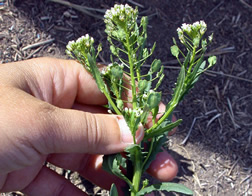This page has been archived and is being provided for reference purposes only. The page is no longer being updated, and therefore, links on the page may be invalid.
|
|
Midwestern Weed May Inspire Newfound Respect
By Jan SuszkiwNovember 1, 2006
Soybean farmers in the Midwest have little use for field pennycress. But that may change. Agricultural Research Service (ARS) scientists in Peoria, Ill., are eyeing the annual winter weed's seed as both a biodiesel resource and biobased fumigant.
ARS research leader Terry Isbell notes that seed of pennycress, Thlaspi arvense, is 36 to 40 percent oil by weight. Additionally, long-chain fatty acids derived from its oil are similar to those of other biodiesel resources, including animal fats and soybean and sunflower oils. Biodiesel from these sources can be used alone or mixed with petroleum-based diesel to lower the emission of hydrocarbons, carbon monoxide and other pollutants in engine exhaust.
This winter, Isbell and colleagues at the ARS National Center for Agricultural Utilization Research (NCAUR) in Peoria hope to convert pilot-scale amounts of pennycress oil into biodiesel so that they can further examine its characteristics. This hinges on the successful harvest of a 10-acre pennycress crop grown near Hanna City, Ill., expressly for that purpose.
But why bother, if soybeans can be used? One reason is that pennycress and soybeans often share the same crop fields. Farmers try to oust pennycress by spraying herbicide in the spring before planting soybeans, but the weed has already produced seed by then. Treating it as another crop rather than a weed could enable farmers to use their land to produce fuel in the winter from pennycress and food in the summer from soybeans, notes Isbell.
Pennycress' seed production—1,500 to 2,000 pounds per acre—could be well-suited to biodiesel applications. Isbell estimates oil from 1,000 pounds of seed will yield 50 gallons of biodiesel.
Crushed seed left over from biodiesel production, called meal, also has promise as an organic fertilizer and soil fumigant for low-acreage, high-value crops, reports NCAUR researcher Steve Vaughn. In field tests, the seedmeal's decomposition released allyl isothiocyanate and other substances that kept sicklepod and other weeds from germinating.
ARS is the U.S. Department of Agriculture's chief scientific research agency.


 Seed of field pennycress might be useful for making biofuel and a nature-based weed killer.
Seed of field pennycress might be useful for making biofuel and a nature-based weed killer.